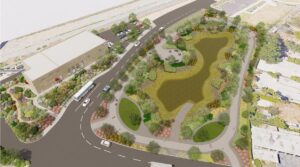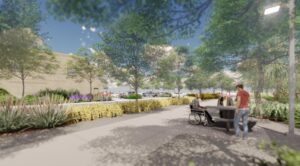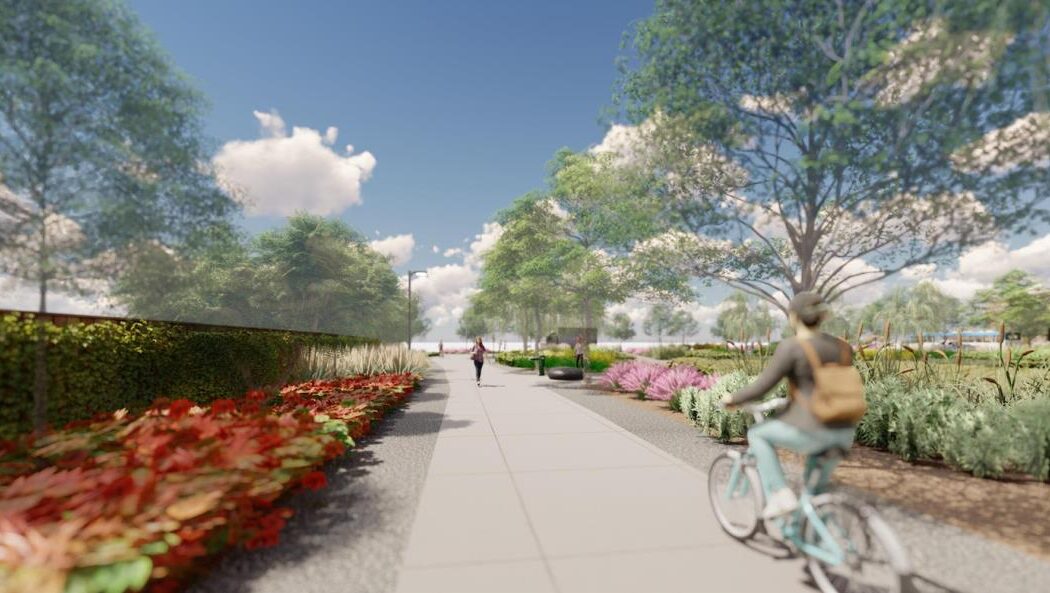In April of 2022 in Long Beach, California, the city’s Municipal Urban Stormwater Treatment Project won an Envision Platinum Award for Sustainable Infrastructure from the Institute for Sustainable infrastructure (ISI).
The Long Beach Municipal Urban Stormwater Treatment Project (LB-MUST) is a comprehensive and innovative regional project that—among other community and environmental benefits—will help restore the Los Angeles River and Estuary.
 It will intercept and treat dry weather runoff and first-flush storm flows generated within the City of Long Beach before discharging to the LA River and Estuary.
It will intercept and treat dry weather runoff and first-flush storm flows generated within the City of Long Beach before discharging to the LA River and Estuary.
The centralized downstream advanced treatment facility has a planned capacity capable of collecting and diverting approximately 41% of the City’s 12,200-acre watershed. This facility will assist with the compliance with the National Pollutant Discharge Elimination System Permit.
Ed Othmer, PE, CPESC, CPSWQ, QSP/D ToR, QISP ToR, ENV SP, PMP, Project Manager and Vice President Wet Weather Flow Sector Leader, Stantec, explained “LB-MUST is an ambitious, comprehensive, and innovative project to intercept and treat dry weather runoff and a percentage of the first-flush storm flows generated within the City of Long Beach. At the outset, I envisioned this project as more than just a stormwater treatment facility – I wanted LB-MUST to be the flagship regional project along the LA River that fostered broader community collaboration to inform greater sustainable decisions. I’m thankful to the City of Long Beach for allowing me to manage this amazing project.”
This treatment facility will assist with the compliance with the National Pollutant Discharge Elimination System (NPDES) Permit, including Total Maximum Daily Loads (TMDL).
 Treated water can be used as an alternative water supply for the irrigation of City parks and for a wetland to be constructed next to the treatment facility, which will provide additional treatment/water polishing and a recreational amenity for the nearby community. The treatment facility will include educational elements, including opportunities for guided public tours.
Treated water can be used as an alternative water supply for the irrigation of City parks and for a wetland to be constructed next to the treatment facility, which will provide additional treatment/water polishing and a recreational amenity for the nearby community. The treatment facility will include educational elements, including opportunities for guided public tours.
The LB-MUST treatment facility treats non-brackish and brackish influent flows separately. The treatment facility will handle an initial capacity of 2 million gallons per day (mgd) up to a future capacity of 4 mgd.
The LB-MUST project is a prime example of a project in the Lower Los Angeles River Watershed that provides incentives for water agencies throughout each watershed to collaborate in managing the region’s water resources and setting regional priorities for water infrastructure and improving the region’s water self-reliance.
This is a multi-benefit infrastructure project that achieves many essential goals such as:
- Advancing local hire and job training goals.
- Using nature-based solutions.
- Providing benefits to disadvantaged communities and economically distressed areas.
- Providing inspiration and education to other agencies and the community, such as delivering multi-benefit solutions to address community challenges.
After proceeding through a rigorous independent third-party project verification process, the LB-MUST project earned Envision Platinum for sustainable infrastructure from the Institute for Sustainable Infrastructure.
In addition, the project demonstrated many sustainability achievements, several of which are described below.
Colin Averill, PE, Civil Engineer, City of Long Beach Public Works, Engineering Bureau, said “Long Beach continues its commitment to improving water quality by delivering an innovative project to treat stormwater and urban runoff with capacity for a substantial portion of the City’s watershed. Sustainability extends beyond the project limits with water reuse, community, and environmental benefits that will support expanded greenspace along the LA River.”
KEY SUSTAINABILITY ACHIEVEMENTS
- Improving environmental justice for underserved and disadvantaged communities. According to population statistics, the LB-MUST project is in a severely disadvantaged community (SDAC) with low park access and is in the 90th percentile for pollution burden. There is a strong correlation between SDACs and unfair environmental and social justice treatment. To help remedy this, the project will improve the surrounding SDAC by converting the existing land use from an industrial corridor to a one-acre wetland landscaped area. The replacement of an industrial facility with park landscaping will improve neighborhood access to these new recreational resources and improve community health and connectivity.
- Achieving a net positive water impact. The project will achieve a net positive water impact and help improve water quality in the LA River. The project’s primary goal is to treat urban runoff (dry weather flow), and portions of the first-flush stormwater flow to comply with the City’s NPDES permit. Instead of urban runoff being discharged unabated into the LA River, it will be treated and can be used as an alternative water resource to offset the demand for freshwater resources. The LB-MUST facility will also treat and discharge brackish water, which will be used to sustain the constructed wetland adjacent to the facility. When the LB-MUST project is fully built, 1,778 acre-feet per year of dry weather flow will be captured and treated, of which 827 acre-feet will be freshwater that can be used to offset the water supply and used as a resource annually.
- Encouraging the use of alternative modes of transportation to access the site. Most trips in the City of Long Beach are made by single occupancy motorized vehicles due to limited mass transit and active transportation options. The LB-MUST project has been designed to encourage visitors and employees to commute to the site using active transportation options (cycling and walking). It has integrated sustainability requirements to promote cycling facilities (bike storage, onsite showers, locker room, restrooms). In addition, for those arriving by car, the LB-MUST facility will allocate three of 16 parking spaces for electric vehicles.
- Adding public space and amenities through meaningful restoration efforts. The project site is currently a greyfield consisting of 1.23 acres of land developed with an industrial facility and parking lot. Aside from a few small planters, the area is paved. This space will be restored to a publicly accessible wetland and provide much-needed public amenities such as walking and biking paths, rest areas, and educational signage. The project will also improve connectivity to adjacent amenities like the LA River Bike Path and the Drake/Chavez soccer fields.
- Protecting the natural world. This project earned top scores for managing stormwater, reducing pesticide and fertilizer impacts, preventing surface and groundwater contamination, preserving species biodiversity, and restoring previously disturbed soils.
- Preparing for long-term adaptability. By enhancing habitats, providing additional water resources to the community, reducing dependency on energy for treatment processes, and making sustainable siting decisions, this project has been designed to be resilient through the long-term consequences of climate change on both a micro and macro scale.
- Implementing meaningful stakeholder engagement programs to improve the overall design and sustainability of the project. Stakeholder engagement for this project has gone beyond the LB-MUST internal project design meetings to solicit feedback from the wider community, including the public, businesses, tenant and other community organizations, conservation groups, and Native American tribes. As part of the design charrettes for this project, stakeholders were consulted on passive design and sustainability characteristics, material finishes, project scale and context, public education components, ecosystem enhancements, and public amenities. Feedback from stakeholders has been very positive and helped influence the project’s design.
Melissa Peneycad, managing director of ISI, said “Achieving Envision Platinum affirms the City of Long Beach’s commitment to sustainability and sets an example for other public and private developments. This multi-benefit project is a prime example of an infrastructure project that incorporates nature-based solutions to minimize environmental impact while meeting the long-term needs of the communities it serves. Also, the regional cooperation deployed and implemented to achieve the project’s goals is outstanding and serves as inspiration for other regions. Congratulations to the City of Long Beach and its project partners on this terrific achievement.”
Treated water can be used as an alternative water supply for the irrigation of City parks and for a wetland to be constructed next to the treatment facility. The treatment facility will include educational elements, including opportunities for guided public tours.
Images courtesy of City of Long Beach.

